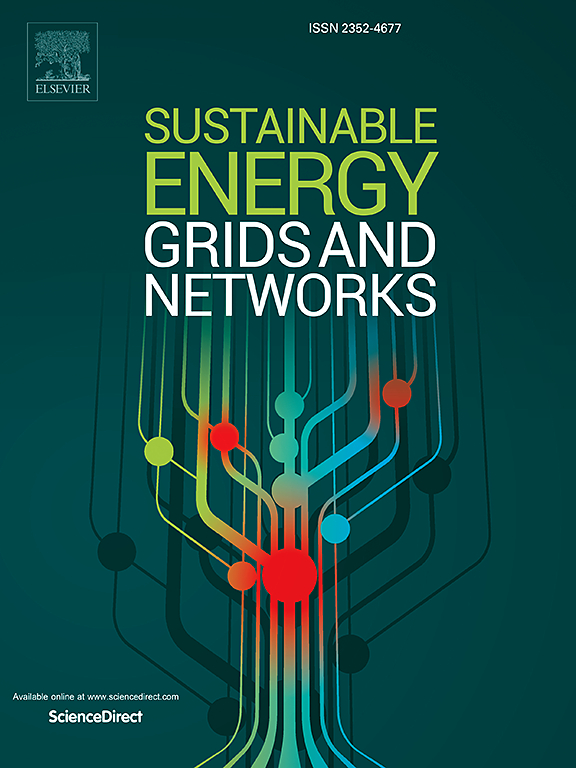基于LARG供应链方法的城市-工业共生网络多目标多能量优化模型
IF 5.6
2区 工程技术
Q2 ENERGY & FUELS
引用次数: 0
摘要
城市-工业共生是循环经济中的一种新方法,促进相邻城市和工业区之间资源开发和管理的协同作用。一种特殊的形式,以能源为基础的共生,强调了这些地区能源的综合供应。本文提出了一种新的城市-工业共生能源网络中多能优化模型。该模型为工业和住宅部门提供了电力、供暖、制冷和氢气的综合供应。为了实现这一目标,我们制定了一个优化问题,重点是确定最佳设备容量和能量流。一个关键的创新是将LARG供应链范例整合到能源网络建模中:精益(即成本最小化)、敏捷(即转移需求最小化)、弹性(即解决能源需求和可再生能源发电的不确定性)和绿色(即二氧化碳排放最小化)。采用多目标方法对该问题进行了建模,并在考虑季节和日需求变化的城市-工业共生区域进行了数值模拟。结果说明了能量流在全天和跨季节的最佳分布。目标函数值强调了LARG范式之间的内在权衡。对于多目标问题所选择的解决方案有效地平衡了这些目标,实现了转移需求减少55% %,二氧化碳排放量减少22% %,而成本仅增加5% %。研究结果还强调了促进工业共生网络优化战略与能源政策制定之间协同作用的重要性,以同时增强能源安全和环境可持续性。本文章由计算机程序翻译,如有差异,请以英文原文为准。
A new multi-objective multi-energy optimization model in the urban-industrial symbiosis network using LARG supply chain approach
Urban-industrial symbiosis represents a novel approach within the circular economy, promoting synergy in resource development and management between adjacent urban and industrial areas. A particular form, energy-based symbiosis, emphasizes the integrated supply of energy across these areas. This paper presents a new model for multi-energy optimization within an urban-industrial symbiosis energy network. The model enables the integrated supply of electrical, heating, cooling, and hydrogen to both industrial and residential sectors. To achieve this, we formulated an optimization problem focused on determining optimal equipment capacities and energy flow. A key innovation is the integration of LARG supply chain paradigms into the energy network modeling: lean (i.e., cost minimization), agile (i.e., shifted demand minimization), resilient (i.e., addressing uncertainties in energy demand and renewable energy generation), and green (i.e., CO2 emissions minimization). The problem was modeled using multi-objective approach, and numerical simulations were conducted on an urban-industrial symbiosis area, accounting for seasonal and daily demand variations. The results illustrate the optimal distribution of energy flow throughout the day and across seasons. The objective function values highlight the inherent trade-offs between the LARG paradigms. The chosen solution for the multi-objective problem effectively balances these objectives, achieving a 55 % reduction in shifted demand and a 22 % reduction in CO2 emissions, with only a 5 % increase in costs. The findings also emphasize the importance of fostering synergies between optimization strategies for industrial symbiosis networks and energy policy-making, to simultaneously enhance energy security and environmental sustainability.
求助全文
通过发布文献求助,成功后即可免费获取论文全文。
去求助
来源期刊

Sustainable Energy Grids & Networks
Energy-Energy Engineering and Power Technology
CiteScore
7.90
自引率
13.00%
发文量
206
审稿时长
49 days
期刊介绍:
Sustainable Energy, Grids and Networks (SEGAN)is an international peer-reviewed publication for theoretical and applied research dealing with energy, information grids and power networks, including smart grids from super to micro grid scales. SEGAN welcomes papers describing fundamental advances in mathematical, statistical or computational methods with application to power and energy systems, as well as papers on applications, computation and modeling in the areas of electrical and energy systems with coupled information and communication technologies.
 求助内容:
求助内容: 应助结果提醒方式:
应助结果提醒方式:


